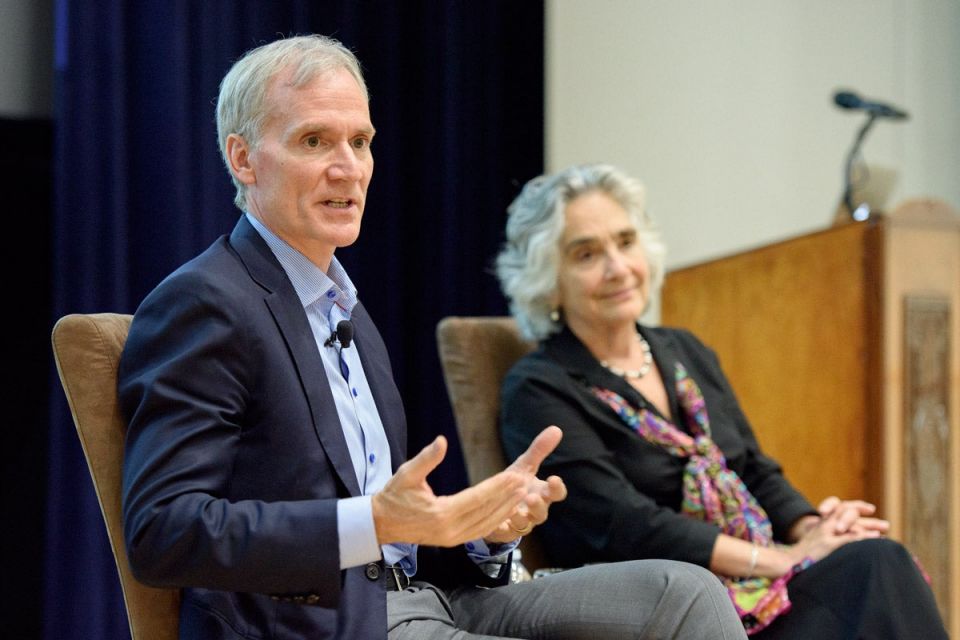
President Marc Tessier-Lavigne and Provost Persis Drell at the town hall meeting on long-range planning. (Image credit: L.A. Cicero)
Since the university’s long-range planning process was launched earlier this month, some 50 proposals and ideas have been submitted by members of the campus community who are suggesting future challenges the university might confront and ways the university’s foundation can be strengthened.
That might be a good start, but many more good ideas are being sought by President Marc Tessier-Lavigne and Provost Persis Drell, who launched the planning process to invite campus collaboration in creating a shared vision for the university for the next 10 to 15 years and beyond.
The president and provost made that message loud and clear during a Friday town hall meeting held to explain the planning process, encourage idea submissions and answer questions.
Faculty, staff and students filled Cubberley Auditorium to listen to the president explain the long-range planning process and to follow up with questions to Tessier-Lavigne and Drell from the audience concerning a wide range of issues, from the availability of affordable housing to services for graduate students to expanding student participation in university programming.
Three planning phases
The planning process is currently in phase one, which extends through June. During this phase, members of the campus community are strongly encouraged to submit ideas and proposals through the main long-range planning website, called The Purposeful University.

Student Tim Schnabel asking a question at the town hall meeting on long-range planning. (Image credit: L.A. Cicero)
The submissions can be informal and need not be polished. They only need to address such conceptual categories as advancing frontiers, strengthening foundations, stimulating synergies or anticipating change.
Members of the long-range planning team are available to provide advice and resources to help members of the community submit ideas or design proposals. They can be reached via email at stanford_planning@stanford.edu.
Phase two, which will run from July through October, involves proposal analysis by steering groups that have been charged with overseeing four conceptual areas: Education, Research, Our Community and Engagement Beyond Our Community. Phase three, which extends from November through February 2018, involves the synthesis of ideas by the president, provost and executive cabinet.
So far, nearly 36 percent of the submitted ideas have come from faculty, 36 percent from staff, 15 percent from students and 13 percent from academic staff. Most submissions come under the auspices of the Our Community group, followed by Education, Research and Engagement Beyond Our Community.
The president cited examples of submissions to help attendees articulate their ideas:
- Advance a new vision of precision healthcare focused on identifying and preventing likely conditions
- Enable and support remote work arrangements and create satellite work sites in the Bay Area
- Establish partnerships with the local community to advance the education, research and service relating to individuals with disabilities
- Address inequality of opportunity, wealth and income
As ideas and submissions are evaluated for inclusion in long-range plans, Tessier-Lavigne said he, the provost and members of the executive cabinet will be looking for initiatives that “enable the university to be more than the sum of its parts.”
Steering groups

Professor Susan McConnell chairs one of the long-range planning steering committees. (Image credit: L.A. Cicero)
Among those attending the town hall were chairs of two of the four steering groups, including Robert MacCoun, professor of law, who co-chairs Research; Ramesh Johari, associate professor of management science and engineering, who co-chairs Our Community; and Susan McConnell, professor of biology, who also co-chairs Our Community. Each reiterated the president and provost’s encouragement for idea submission.
“We want to stress that everyone is welcome to submit ideas,” said MacCoun. “Part of the message we really want to convey is that this is a bottom-up process.”
“We are dependent on you,” said Johari. He encouraged town hall participants to submit their own ideas, but also to encourage others to do so.
McConnell added, “Your collective wisdom can really frame this process.”
The process is designed to engage the university to create a shared vision based on three objectives:
- To educate students to think broadly, deeply and critically as engaged world citizens and leaders
- To extend the frontiers of knowledge and stimulate creativity
- To amplify the university’s contributions to our country, humanity and an increasingly complex and interdependent world
Tessier-Lavigne has pointed out that the last university-wide planning process occurred more than a decade ago, making “the time right” for a new engagement process. Although not focused specifically on planning a capital campaign, the vision will later help lead a campaign to support the innovative ideas that are adopted.
For more about the long-range planning process, visit The Purposeful University.